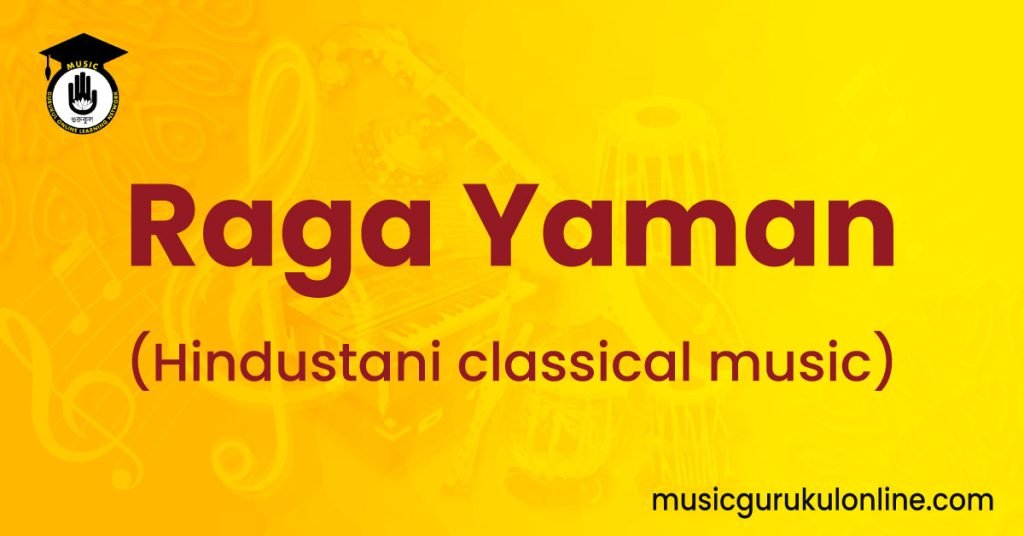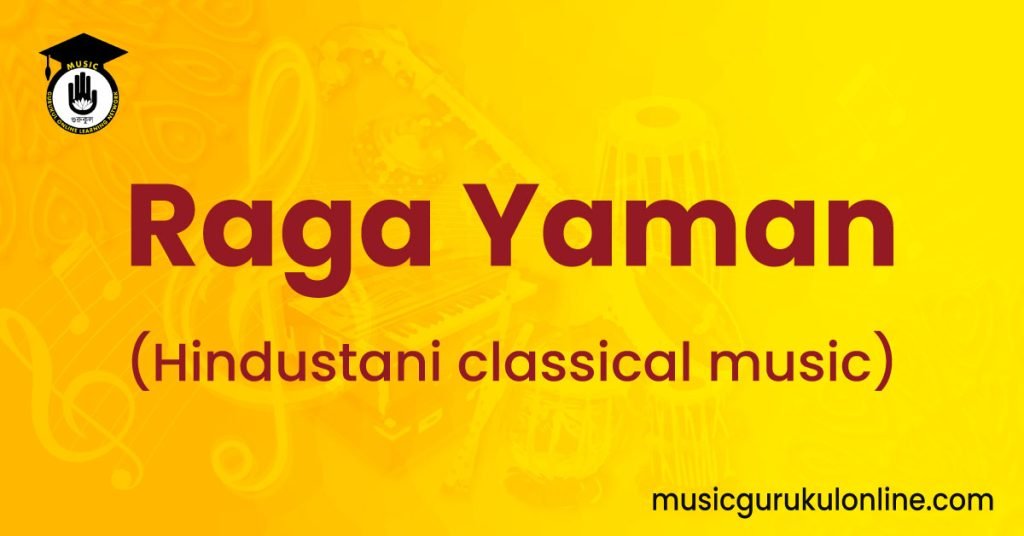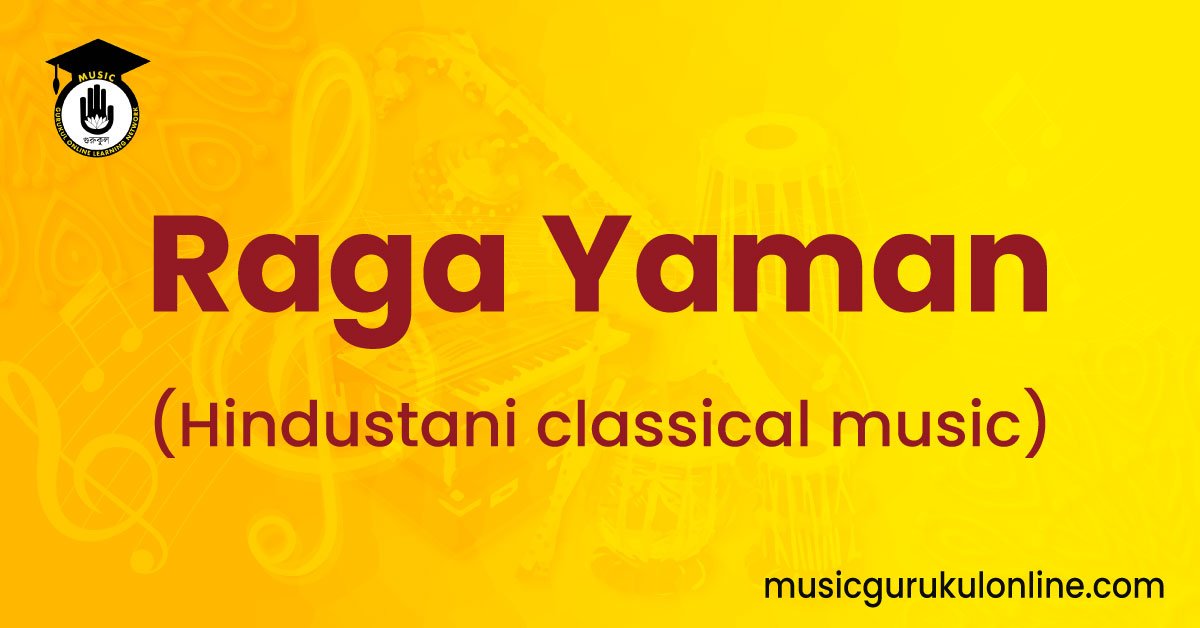Raga Yaman, also known as Raag Yaman or Raga Eman, is one of the most popular and revered ragas in the Indian Classical Music tradition. It is a popular raga in the Hindustani classical music tradition and is used in a variety of musical compositions including bhajans, ghazals, and film songs. In this article, we will explore the various aspects of Raga Yaman including its structure, aroh-avroh, vadi and samvadi, pakad or chalan, organization and relationships, behaviour, samay or time, rasa, history or origins, important recordings, and film songs based on this raga.

Table of Contents
Structure of Raga Yaman:
Yaman’s Jati is a Sampurna raga (ideally, yaman is audav sampoorna raag because of the structure- N,RGmDNR’S’ NDPmGRS) and in some cases Shadav; the ascending Aaroha scale and the descending style of the avroha includes all seven notes in the octave (When it is audav, the Aroha goes like N,RGmDNS’, where the fifth note is omitted; Pa but the Avaroha is the same complete octave). All the scale notes (called swaras) in the raga are Shuddha, the exception being Teevra Madhyam or prati madhyamam (sharp fourth). The notes of the raga are considered analogous to the western Lydian mode.
It is a morning raga that is usually performed during the first part of the day. It belongs to the Kalyan thaat which is a parent scale in Indian classical music. The raga has a unique and complex structure and can be sung or played in a variety of ways depending on the individual style of the musician.
Aroh-Avroh:
The aroh-avroh of Raga Yaman is as follows:
Aroh: Sa Re Ga Ma Pa Dha Ni Sa’
Avroh: Sa’ Ni Dha Pa Ma Ga Re Sa
As we can see, the raga has a linear ascent with the notes Sa, Re, Ga, Ma, and Pa forming the aroh or the ascending notes and the notes Pa, Ma, Ga, Re, and Sa forming the avroh or the descending notes. The raga does not use the note ‘ni’ in the ascending order, but it is used in the descending order.
Vadi and Samavadi:
The vadi swara is the most important note in a raga and it is the note that is emphasized the most in the composition. In Raga Yaman, the vadi swara is ‘Ga’ and the samvadi swara is ‘Ni’. The vadi and samvadi swaras play an important role in the composition and are used extensively by the musician to create a unique and distinct sound.
Pakad or Chalan:
The pakad or chalan of a raga is a unique melodic phrase that captures the essence of the raga. In Raga Yaman, the pakad is:
‘Ni Re Ga Ma, Ga Re Sa’
This phrase captures the essence of the raga and is used extensively in the composition.
Its signature phrase (Pakad) is ni-Re-Ga-/Re-Ga/ni-Re-Sa/Pa-Ma#-Ga-Re/ni-Re-Sa’ (Ma is teevra).
Tonal movements of the notes mostly reflect zigzag motion with gap of one or several notes usually that prefer reverse order very often like DNS’ mDN GmD RGm N,GR or MDNS’ GmDN RGmD N,RGm D,N,GR etc. Ideally yaman should not use PR combination but can use P~R showing colour of m or G while gliding from P to R, for PR is one of the specific identification of raag kalyaan.

Organization and Relationships:
Raga Yaman is a versatile raga and can be used in a variety of musical compositions. It is usually performed during the first part of the day and is associated with the spring season. The raga has a close relationship with other ragas such as Raga Bhimpalasi, Raga Pilu, Raga Desh, and Raga Kafi. The relationships between these ragas are complex and are based on a variety of factors such as the notes used, the melodic structure, and the mood.
Behaviour:
Raga Yaman is a raga that is full of life and energy. It has a happy and joyful mood and is associated with the spring season. The raga is usually performed in a fast tempo and is characterized by intricate and complex melodic patterns.
Samay or Time:
Raga Yaman is traditionally performed during the late evening, between 9 pm to midnight. It is a time when the mind is relaxed, and one can fully immerse oneself in the contemplative and meditative mood of the raga. The slow and measured pace of Yaman lends itself well to the peaceful atmosphere of the night, making it an ideal raga for contemplative listening.
Rasa or Emotion:
Raga Yaman is associated with the emotion of Shringar, which translates to love and romance. It evokes a sense of longing and desire, and its contemplative mood is perfect for expressing deep emotions. Yaman is also known for its peaceful and calming effect, making it an ideal raga for meditation and introspection.
History or Origins:
The exact origins of Raga Yaman are unclear, but it is believed to have originated from the ancient Vedic tradition of India. The raga has been mentioned in various ancient texts, including the Sama Veda and the Natya Shastra. Yaman has also been a popular raga in the Hindustani Classical Music tradition for centuries, with many great musicians, such as Ustad Amir Khan, Ustad Bade Ghulam Ali Khan, and Pandit Bhimsen Joshi, having performed and recorded it.
Important recordings:
There have been numerous recordings of Raga Yaman by various artists over the years, but some of the most important ones are:
- Ustad Amir Khan’s rendition of Yaman on his album “Ragas Yaman and Bageshri” is considered to be one of the greatest recordings of the raga. His performance showcases his incredible vocal range and control, as well as his mastery of the raga’s nuances.
- Pandit Bhimsen Joshi’s rendition of Yaman on his album “Classical Wonders of India” is another classic recording of the raga. Joshi’s powerful and emotive voice brings out the deep emotions of the raga, while his impeccable technique and control add to the beauty of the performance.
- Ustad Bade Ghulam Ali Khan’s rendition of Yaman on his album “Great Maestros of Hindustani Classical Music” is another important recording of the raga. Khan’s unique style and vocal range make his performance of Yaman truly unforgettable.
Film songs based on Raga Yaman:
Raga Yaman has also been used extensively in Indian film music, with many popular songs based on the raga. Some of the most famous film songs based on Yaman are:
- “Tere Bina Zindagi Se” from the film “Aandhi” is a classic song based on Yaman. Composed by R.D. Burman and sung by Lata Mangeshkar and Kishore Kumar, the song’s serene melody and evocative lyrics make it a timeless classic.
See more:
